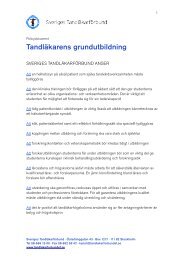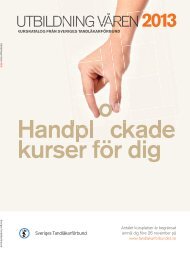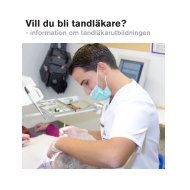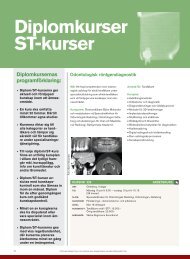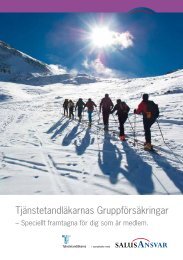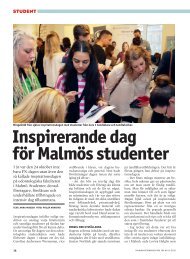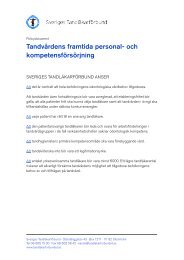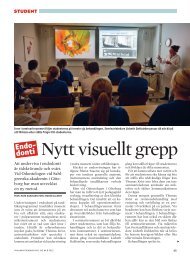Swedish Dental Journal
Swedish Dental Journal
Swedish Dental Journal
You also want an ePaper? Increase the reach of your titles
YUMPU automatically turns print PDFs into web optimized ePapers that Google loves.
Clinicians<br />
<strong>Dental</strong> students (DS):<br />
Thirty-seven dental students, in their final month of a<br />
5 year-education, at the Faculty of Odontology, Malmö<br />
University were asked to participate. Twenty-two<br />
of the students answered the questionnaires. Thirteen<br />
were females and nine were males. The mean age was<br />
27 years (range 24-36) for the females and 26 years<br />
(range 24-30) for the males. Fifteen students could<br />
not participate due to other commitments; these students<br />
were therefore not obliged to participate.<br />
<strong>Dental</strong> hygienists students (DHS):<br />
Sixteen dental hygienist students in their final<br />
month of a 2 year-education at the Faculty of<br />
Odontology, Malmö University were asked to participate.<br />
Fourteen females and one male of a total<br />
of 16 students participated. The mean age was<br />
31 years (range 21-45 years). One student did not<br />
participate due to illness.<br />
<strong>Dental</strong> teachers (DT):<br />
Eighteen dental teachers in the Comprehensive<br />
Care Clinic (CCC) at the Faculty of Odontology,<br />
Malmö University, were asked to participate. The<br />
teachers worked at the CCC four to sixteen hours<br />
per week. Twelve teachers participated, four of<br />
these were specialists in prosthodontic, two in<br />
periodontology and six were general dental practitioners.<br />
Six teachers were females and 6 were<br />
males. The mean age was 47 years (range 34-67);<br />
for the males 53 years and for the females 41 years.<br />
The mean age of the 18 teachers that worked at the<br />
CCC were 45 years (range 34-67). The questionnaires<br />
were returned anonymously in such a way<br />
that no drop-out analyses could be performed<br />
without unmasking the anonymity. The dropouts<br />
could easily have been identified since they<br />
were all known by the authors according to age,<br />
gender and speciality.<br />
leisnert, hallström, knutsson<br />
Supervisors in the Public <strong>Dental</strong> Health Service (S):<br />
Thirty dentists in the Public <strong>Dental</strong> Health service,<br />
who also have a role as supervisors for dental students<br />
in their period of outreach training (18), were<br />
asked via e-mail if they would participate. Twentyseven<br />
supervisors, 15 females and 12 males, participated<br />
in the study. The mean age was 52 years (range<br />
36-45) for the females and 49 years (range 30-64) for<br />
the males. Three of the 30 dentists did not participate<br />
due to other commitments.<br />
Analysis<br />
If differences existed between the numbers of findings<br />
each category used was analysed with one way<br />
analysis of variance (ANOVA). If differences existed,<br />
Turkey’s test was used to analyse between which categories<br />
these differences existed. Differences between<br />
different categories use of respectively findings were<br />
analysed using chi-square test (P=0.05).<br />
Results<br />
Analysis of the answers<br />
After the data had been collected the questionnaires<br />
were read by all the authors. Analyses of the answers<br />
were performed stepwise. In a first step, the questionnaires<br />
were scrutinised to find content-word or<br />
concepts that could be coded as a finding. Twentyfive<br />
different findings were identified as findings the<br />
clinicians used to diagnose chronic periodontitis. In<br />
a second step different content-words or concepts<br />
that could be interpreted as the same finding were<br />
brought together. For example bleeding on probing<br />
and bleeding index were registered as bleeding.<br />
Further, subgingival and supragingival calculus was<br />
registered as calculus, and plaque and plaque index<br />
were registered as plaque. In a third step, findings<br />
registered by less than three participants, were excluded.<br />
Such findings were age, halitosis, genetics, and<br />
diabetes. After these steps, 13 findings remained and<br />
were further analysed.<br />
Table 1. The most frequently used findings (N=13) by four different categories of clinicians when they diagnose chronic<br />
periodontitis. The findings are divided into three subgroups.<br />
Soft tissue inflammation findings Loss of supporting tissue findings Irrelevant findings<br />
-bleeding -marginal bone loss -plaque<br />
-pus -marginal bone loss changed over time -calculus<br />
-marginal bone loss on >1/3 of root length -smoking<br />
-vertical bone pocket -mobility<br />
-attachment loss<br />
-furcation involvement<br />
-deepened pocket<br />
118 swedish dental journal vol. 32 issue 3 2008




